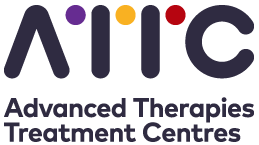
Case Studies
Supporting the NHS workforce to work with low temperature ATMP shipments

The Challenge

Advanced therapy medicinal products (ATMPs) often require storage and transportation at ultra-low temperatures (typically down to -85°C) or at cryogenic temperatures (usually below -150°C). Dry ice, ultra-low freezers and vapour phase nitrogen dry shippers (Figure 1) are commonly used to support the complex transportation requirements of gene and cell therapies. Equipment and materials must be used safely and correctly, both to protect the user and achieve optimal product shelf life.
It is likely that, as the usage of ATMPs grows, clinical departments such as hospital pharmacies will be required to receive shipments and store products at ultra-low or cryogenic temperatures. This challenge is not limited to ATMPs – it applies to all medicines requiring receipt and storage at cryogenic or ultra-low temperatures, such as some novel vaccines that have been developed in response to the COVID-19 pandemic.
It is strongly recommended that any department involved in the receipt and handling of shipments in dry ice or in vapour phase nitrogen shippers carries out a detailed risk assessment, to ensure that staff are aware of the risks and that procedures are in place to mitigate those risks as far as possible.
All staff in these departments need to know how to work with these shipments safely. They require access to training resources, which provide a trusted source of information, as well as tools to support training managers in assessing and recording staff competency.
The solution
To address this challenge, three interlinked resources have been developed by the MW-ATTC with the aim of supporting NHS staff who are new to working with these types of shipment.
All materials were reviewed by a panel of subject matter experts. The resources are:
• Exemplar Risk Assessments for the receipt of products at ultra-low temperatures.
• An e-learning module on the Safe Use of Low Temperature Transport Vessels.
• A template competency assessment checklist, supported by assessor guidance notes.
The exemplar risk assessments were produced by Nia Evans, Consultant Pharmacist in Advanced Therapies and Haematology for Cardiff & Vale University Health Board. These documents have been written to illustrate how a hospital pharmacy might approach a risk assessment of the receipt and handling of shipments on dry ice or in nitrogen vapour dry shippers. They are aimed at clinical sites that are new to working with these types of shipments, who can adapt the risk assessment documents according to their local needs.

Development of the e-learning module and competency assessment tools were led by Ceri Roberts, Scientific Training Manager in Cellular and Molecular Therapies for NHS Blood and Transplant. The e-learning module was developed by NHSBT’s Digital Learning team. It is now available to all NHS and UK university staff via the e-Learning for Healthcare platform.
Nearly 800 users have now been awarded an attainment certificate following successful completion of the e-learning module and associated e-assessment. The module has an overall user rating of 4.8/5 and has attracted positive feedback (Box 1). The e-learning module is supported by a competency assessment tool that can be adapted and used by healthcare teams to evaluate staff competency to work with low temperature shipments.
The results

Following discussions in the UK Pharmacy Working Group for ATMPs, these three related resources (exemplar risk assessments and competency assessment tools, as well as signposting to access the e-learning module) were combined together into a single document aimed at supporting hospital pharmacies. This document was edited by Anne Black, Regional Quality Assurance Specialist Pharmacist and Chair of the UK Pharmacy Working Group for ATMPs, and has now been published on the Specialist Pharmacy Service website (Figure 2).
Although aimed at hospital pharmacies, this resource may be of interest for any teams working with dry ice and/or vapour phase nitrogen shippers. Potentially interested parties may include cell therapy laboratory staff, clinical research facilities, clinical haematology teams, hospital stores or estates personnel and research institutions. It is important to note that risk assessments and staff competency assessment will always require adaptation according to local requirements.
The final document can be accessed via the UK Pharmacy Working Group for ATMPs webpage.
Making further impact
Preparations are currently underway across the UK for delivery of several different COVID-19 vaccines, some of which come with ultralow temperature storage requirements and are likely to be transported on dry ice. It is hoped that the timely availability of these new resources, produced by MW-ATTC and published via the Specialist Pharmacy Service, may help to support UK-wide preparations for COVID-19 vaccine delivery.
